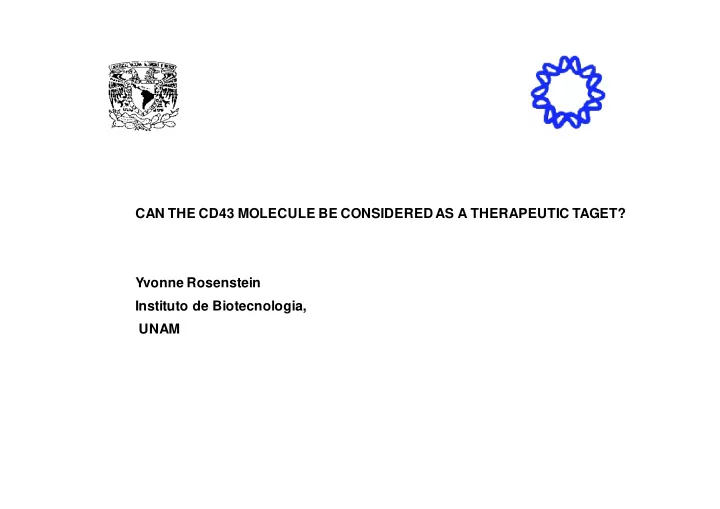

CAN THE CD43 MOLECULE BE CONSIDERED AS A THERAPEUTIC TAGET? Yvonne Rosenstein Instituto de Biotecnologia, UNAM
CD43: � the molecule and its signaling capacities � favors a Th1 differentiation pattern and contributes to the decision making process of T lymphocytes � participates in non-lymphoid tumors
CD43: � the molecule and its signaling capacities � favors a Th1 differentiation pattern and contributes to the decision making process of T lymphocytes � participates in non-lymphoid tumors
serine, CD43 threonine and proline residues CD4 45 nM 60% of the molecular mass Sialic acid Expression: Galactose •All lymphoid cells N-acetylgalactosamine (except erythrocytes), • Epithelial tumors 115 kDa/135 kDa 123 aa Intracytoplasmic region: -no enzymatic activity - no tyrosine residues -serine and threonine residues potentially phosphorylable -Proline rich region -ERMs binding region
L-selectin CD2 CD4 HSA 2 4 Sialyl Lex E- CD33 SiGlec-1 selectin PSGL-1 CD83 ICAM-1 LF A-1 CD43 MHC I CD8 Transialidase T. cruzi S. gordinii ACTIVATION Galectin-1 Anti-CD43 Abs CD7 CD45 M. tuberculosis GM 1 CD4 CD3 HOMING ADHESION CD43 INFLAMMATION APOPTOSIS PROLIFERATION ANTI- ADHESION CYTOSKELETON REARRENGEMENTS
CD3 CD43 ζ ζ Y Y Y Y Y Y Y Y Y Y Y Y vía PLC γ vía Rho Family vía Ras vía PI3K PIP Shc Rac R a s PIP Lck PLC γ PIP2 S h c 2 3 PI3K GTP GTP Grb2 G r b 2 Vav S o s IP3 DAG GTP GTP R a f PDK1 PKC P M e k AKT ++ Ca p38 JNK P E r k ER mTOR Calcineurin Jun Fos NF κ B AP-1 NFA T TRANSCRIPCIÓN DE GENES
CD43: � the molecule and its signaling capacities � favors a Th1 differentiation pattern and contributes to the decision making process of T lymphocytes � participates in non-lymphoid tumors
Is the order important? CD43 ERK SHP-1 adapted from Nat. Rev. Mol. Cell Biol. 2000
CD43 engagement prior or at the same time as the T cR results in sustained ERK phosphorylation A Time (min) 0 2 5 10 15 30 60 120 B pERK IgG1/IgG2 Time (min) 5 10 15 30 ERK pJNK IgG1/IgG2 JNK pERK L10 ERK pJNK L10 C JNK pERK OKT3 Time (min) 10 pJNK ERK OKT3 pERK JNK ERK pERK (L10+OKT3) pJNK TPA (L10+OKT3) ERK pJNK JNK JNK pERK pJNK L10-OKT3 L10-OKT3 JNK ERK pJNK OKT3-L10 pERK OKT3-L10 JNK ERK 1 2 3 4 1 2 3 4 5 6 7 8
CD43 CD43 TCR TCR TCR CD3 CD3 CD3 E R Lck Fyn M PI3-K PLC γ 2 CD3 ζ SHP-1 Vav DAG PIP 2 IP3 PKC Ras MAPKs PKC p70S6K ERK JNK Ca ++ Proliferation apoptosis
CD43 signals provided at the same time or prior to those of the TCR prevent the association of SHP-1 to Lck 2h
T cell proliferation vs anergy : the order matters ? IL-2 PRODUCTION 2h 7 d Proliferation 48h IL-2
CD43 prior or at the same time that the TCR prevents CTLA-4 expression Proliferation Anergy - CTLA-4 -No IL-2 2h 48h CTLA-4
Fold change
CD43 signals induce IL-12R , IFN γ R and IFN γ expression
CD43 CD43 CD3 CD3 CTLA-4 Zap-70 Zap-70 Lck Lck CD3 ζ X SHP-1 CBL CD3 ζ CBL-b SHP-1 ERK ERK Downstream Downstream signals signals T-bet PROLIFERA TION PROLIFERA TION CYTOKINES, ETC CD43+TCR TCR-CD43 CD43-TCR
a b a.1 a.2 b.1 b.2 a.1.1 a.1.2
CD43: � the molecule and its signaling capacities � favors a Th1 differentiation pattern and contributes to the decision making process of T lymphocytes � participates in non-lymphoid tumors
T r minos de la # de entradas bœ squeda (PubMed) CD43 997 CD43 & tumor cells 386 CD43 & lymphomas 261 CD43 & skin 88 CD43 & lung 35 CD43 & breast 15 CD43 & colon 13 CD43 & ovary 10 CD43 & cervix 5 CD43 & thyroid 3 CD43 & metastasis 12
CD43 promotes cell transformation Colonies A and D . NIH ‐ 3T3 mock cells. B and E . NIH ‐ 3T3 ‐ CD43WT. C and F . NIH ‐ 3T3 ‐ CD43 Δ IC.
Baeckstrom et al ., 1995; Santamaria et al ., 1996; Sikut et al ., 1997; Kadaja et al ., 2004; Ziprin et al ., 2004
CD43 enhances wound-healing
Conclusions • CD43 senses the cell’s environment • The quality of the cell’s response can reflect the order with which a cell perceives different signals – Cbl c pSer vs Cblc pY & SHP-1 dependent mechanism • CD43 promotes a Th1 response • CD43-mediated signals lead to the synthesis of numerous cytokynes, cheokines and growth factors, both in normal human T cells and in non-lymphoid human tumor cells • CD43 favors transformation/proliferation/locomotion of non lymphoid tumor cells
Instituto de UAEM Biotecnologia Angélica Santana Gustavo Pedraza Erika Melchy Oswaldo López Funding from : DGAPA/UNAM Nora Fierro CONACYT Amiel Olivos Monserrat Sandoval Maria Elena Bravo Nohemi Camacho Cecilia Martinez
Recommend
More recommend